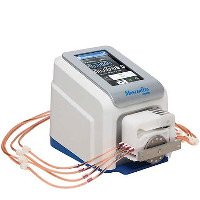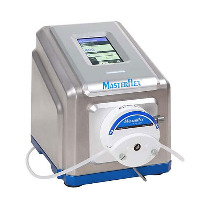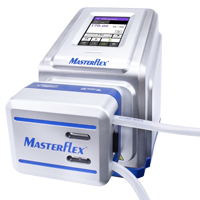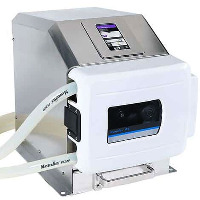How to Choose the Right Masterflex® Pump System
Masterflex® peristaltic pump systems provide superior accuracy and repeatability to ensure optimal performance when used with the proper tubing. These pumps offer the latest technology, including MasterSense™ integrated sensor monitoring to ensure media quality, MasterflexLive® cloud-enabled connectivity, intuitive digital touchscreen capability and the low-maintenance and cost-effectiveness of peristaltic pumps. Our extensive portfolio has what you need to scale from lab to production.
Understanding the Masterflex Pump Families
Masterflex offers four different pump families differentiated by flow rate:
Masterflex Peristaltic Pump Series — Shop by flow range




With each pump option within the Masterflex portfolio, there are typically three primary components that make up a pump system– the pump drive, the pump head, and the pump tubing. Depending upon the pump family you choose, the pump drive and the pump head may be assembled in advance or may need to be ordered separately. For more details, visit Select the Components that Fit Your Requirements.
5 Key Questions to Help Select the right pump system
To help you select the right components needed for your optimal pump system,, answer the five key questions below to better understand the parameters for the Masterflex pump system you need:
What is your application? – Key requirements that may shape your final component selection include the type of environment the pumping will take place, or certain regulatory requirements that are needed for your workflow.
- What media are you pumping? – What are the specific reagents that you will be pumping with your Masterflex pump system? What are the chemical properties (organic/inorganic; pH; etc.) of those reagents? What are the physical properties (viscosity; particulate matter presence; etc.) that could impact the components you choose?
- What flow rate are you pumping? – This could be a static flow rate, or it could be a range of flow rates. Either way, the flow rate is directly impacted by each of the primary components (the pump drive, the pump head, and the pump tubing) of your Masterflex pump system and must be considered when selecting those components.
- What pressure and temperature will you be operating? – Regarding pressure, understanding both the maximum operating pressure as well as those factors that can influence pressure over time (e.g., inline filtration) are important. Additionally, understanding how much “lift” will be needed in your fluid pathway on the inlet side of the pump is also critical. For temperature, knowing the upper and lower limits of the temperature range at which you intend to operate will provide a foundation for the tubing options you can consider.
- What type of instrument control do you need? – Whether you will be controlling your Masterflex pump system locally, analog input, remote control / advanced networking, etc. – understanding what type of control you need to leverage will help qualify the key features in the drive that you choose as part of your Masterflex pump system.
Selecting the Right Components for your pump system
Once you have answered the five key questions listed above, you are ready to begin selecting components for your Masterflex pump system. As mentioned previously, a complete pump system from Masterflex is comprised of three primary components – the pump drive, the pump head, and the pump tubing. For the Ismatec® and B/T® families, the pump drive and the pump head are usually ordered together as a single SKU; however, for the L/S® and I/P® families, the pump drive and the pump head are usually ordered separately.
What to consider when choosing a Masterflex drive
- Flow rate – Each of the Masterflex families is defined by the flow rate range supported by the compatible drives . Therefore, you will want to choose a drive that can deliver the flow rate(s) you need for your application.
- Fixed- or variable-speed – Fixed-speed Masterflex drives are typically less expensive but cannot support on-demand flow rate adjustment; variable-speed drives, however, can adjust the speed – and the flow rate – as needed but are typically more expensive.
- Accuracy of flow rate or dispensed volume – Some drives only offer manually adjusted potentiometer-based modifications to the flow rate, where many offer digital speed control circuitry for those applications that demand highly accurate and more repeatable flow rates.
- Type of control needed – Some Masterflex drives are more basic in operation and thus only support local, benchtop control, whereas other drives can support analog control and even remote control using advanced communication protocols, such as Profibus®, EtherNet/IPTM, etc.
- Sterilization and protection against hazards – Many Masterflex drives offer stainless steel casings and are sealed against dust and water exposure to support wash-down requirements; others, however, are available in different casing options to save on cost.
What to consider when choosing a Masterflex pump head
- Flow rate – Different Masterflex pump heads have different flow rate capacities, depending upon their size and the number of rollers they utilize. It’s important to review the technical specifications of each head to ensure the one you have chosen can support the flow rate(s) needed for your application.
- Frequency of tubing changes – Some Masterflex pump heads are designed for a specific tubing size; that typically do not support rapid tubing changeover. Other pump heads are support multiple sizes of Masterflex tubing and incorporate the rapid tubing changeover functionality.
- Desired number of channels – Knowing how many channels you need to operate – either for increased productivity or for reduction of pulsation – can help inform the Masterflex pump head options you consider.
- Chemical compatibility – Usually, the chemicals being pumped never touch the pump head, but in the event of a chemical spill, the materials used to construct the Masterflex pump heads become a key factor in the selection process.
- Accuracy needed – For the most accurate and repeatable flow rates, choose our standard pump heads that accept only a single size.
What to consider when choosing Masterflex pump tubing
There are many factors to consider when choosing the right pump tubing. For an indepth guide to help you choose, visit our STAMP tubing selection guide . Below is an overview of the selection guide:
- Size – Inner diameter and wall thickness determine key outputs such as flow range, maximum pressure, and ability to handle viscous fluid well. For most applications, our Precision Pump Tubing is an excellent choice.For applications where higher viscosity fluids are present or where higher pressures characterize the fluid pathway, utilizing our High Performance Pump Tubing is the best option. (NOTE: If High Performance Pump Tubing is used, a Masterflex pump drive and pump head that are compatible with that tubing must be chosen.)
- Temperature – Understanding both the fluid temperatures and the environmental temperatures – and comparing those to the ratings assigned to the available tubing materials – can help inform your Masterflex pump tubing selection.
- Application – Some applications have specific industry requirements, such as adherence to federal or other regulations, including FDA 21 CFR 177.2600 and USP Class VI, so reviewing the regulatory approvals of the available Masterflex tubing materials is a must. Understanding the viscosity and particulate presence in the fluid can also help inform your Masterflex pump tubing selection.
- Media – Being familiar with the chemical nature of your reagent(s) and comparing that with the chemical compatibility of the available Masterflex tubing materials is an important consideration. Our Chemical Compatibility Database can help you with the right selection.
- Pressure – Higher pressure often demands the use of thicker-walled Masterflex High Performance pump tubing as well as special connection options that can support those pressures.
Other Accessories to Consider
In addition to the core three components that comprise a Masterflex pump system, there are numerous other items to consider.. Connectors, transfer tubing, and other accessories (e.g., flow rate sensors, pressure sensors, leak detection sensors, pulse dampeners, etc.) are all important accessories that can enhance your overall fluid pathway in meaningful ways by ensuring the safety of the equipment operators while also ensuring minimized downtime and maximized uptime for your equipment and your process. For questions related to these available accessories, please contact your local Avantor Fluid Handling specialist or our Application Support team who are available to help.